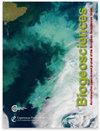Empirical upscaling of OzFlux eddy covariance for high-resolution monitoring of terrestrial carbon uptake in Australia
IF 3.9
2区 地球科学
Q1 ECOLOGY
引用次数: 0
Abstract
Abstract. We develop high-resolution (1 km) estimates of gross primary productivity (GPP), ecosystem respiration (ER), and net ecosystem exchange (NEE) over the Australian continent for the period January 2003 to June 2022 by empirical upscaling of flux tower measurements. We compare our estimates with nine other products that cover the three broad categories that define current methods for estimating the terrestrial carbon cycle and assess if consiliences between datasets can point to the correct dynamics of Australia's carbon cycle. Our results indicate that regional empirical upscaling greatly improves upon the existing global empirical upscaling efforts, outperforms process-based models, and agrees much better with the dynamics of CO2 flux over Australia as estimated by two regional atmospheric inversions. Our nearly 20-year estimates of terrestrial carbon fluxes revealed that Australia is a strong net carbon sink of −0.44 PgC yr−1 (interquartile range, IQR = 0.42 PgC yr−1) on average, with an inter-annual variability of 0.18 PgC yr−1 and an average seasonal amplitude of 0.85 PgC yr−1. Annual mean carbon uptake estimated from other methods ranged considerably, while carbon flux anomalies showed much better agreement between methods. NEE anomalies were predominately driven by cumulative rainfall deficits and surpluses, resulting in larger anomalous responses from GPP than ER. In contrast, we show that the long-term average seasonal cycle is dictated more by the variability in ER than GPP, resulting in peak carbon uptake typically occurring during the cooler, drier austral autumn and winter months. This new estimate of Australia's terrestrial carbon cycle provides a benchmark for assessment against land surface model simulations and a means for monitoring of Australia's terrestrial carbon cycle at an unprecedented high resolution. We call this new estimate of Australia's terrestrial carbon cycle “AusEFlux” (Australian Empirical Fluxes).澳大利亚陆地碳吸收高分辨率监测中OzFlux涡旋相关方差的经验升级
摘要通过通量塔测量的经验升级,我们开发了2003年1月至2022年6月期间澳大利亚大陆总初级生产力(GPP)、生态系统呼吸(ER)和净生态系统交换(NEE)的高分辨率(1公里)估计。我们将我们的估算与其他九种产品进行比较,这些产品涵盖了定义当前陆地碳循环估算方法的三大类,并评估数据集之间的一致性是否可以指出澳大利亚碳循环的正确动态。我们的研究结果表明,区域经验升级大大改进了现有的全球经验升级工作,优于基于过程的模式,并且与两次区域大气逆温估计的澳大利亚上空CO2通量动力学更吻合。我们对近20年陆地碳通量的估计表明,澳大利亚是一个强大的净碳汇,平均为- 0.44 PgC年- 1(四分位间距,IQR = 0.42 PgC年- 1),年际变率为0.18 PgC年- 1,平均季节振幅为0.85 PgC年- 1。从其他方法估计的年平均碳吸收量相差很大,而碳通量异常在各种方法之间显示出更好的一致性。东北东电异常主要受累积降水亏缺和盈余驱动,导致GPP的异常响应大于ER。相比之下,我们发现长期平均季节周期更多地取决于ER的变化,而不是GPP,导致碳吸收峰值通常发生在更凉爽、更干燥的南方秋冬月份。这项对澳大利亚陆地碳循环的新估计为陆地表面模型模拟的评估提供了基准,并为以前所未有的高分辨率监测澳大利亚陆地碳循环提供了手段。我们把这个对澳大利亚陆地碳循环的新估计称为“澳大利亚经验通量”。
本文章由计算机程序翻译,如有差异,请以英文原文为准。
求助全文
约1分钟内获得全文
求助全文
来源期刊

Biogeosciences
环境科学-地球科学综合
CiteScore
8.60
自引率
8.20%
发文量
258
审稿时长
4.2 months
期刊介绍:
Biogeosciences (BG) is an international scientific journal dedicated to the publication and discussion of research articles, short communications and review papers on all aspects of the interactions between the biological, chemical and physical processes in terrestrial or extraterrestrial life with the geosphere, hydrosphere and atmosphere. The objective of the journal is to cut across the boundaries of established sciences and achieve an interdisciplinary view of these interactions. Experimental, conceptual and modelling approaches are welcome.
 求助内容:
求助内容: 应助结果提醒方式:
应助结果提醒方式:


